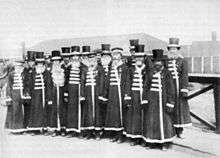Izhevsk–Votkinsk Uprising
| Izhevsk-Votkinsk Uprusing | |||||||
|---|---|---|---|---|---|---|---|
| Part of Russian Civil War | |||||||
| |||||||
| Belligerents | |||||||
| Red Army | Rebels | ||||||
| Commanders and leaders | |||||||
| Woldemar Azin | colonel D.Fedichkin | ||||||
| Casualties and losses | |||||||
| unknown | about 25,000 | ||||||
Izhevsk–Votkinsk Uprising (8 August - 12 November 1918) - part of Russian Civil War.
Background

Izhevsk and Votkinsk were important centers of military production in Russian Empire. Workers of the state military factories and members of their families were about 73-74% of cities population, many families had an old tradition of working in military industry. Workers of military factories had a good salary, many of them owned a pieces of land, used for agriculture.
After the February Revolution of 1917 political life in Izhevsk and Votkinsk began to develop very fast. On 4 May, Izhevsk committee of Russian Social Democratic Labour Party split on Bolshevik and Menshevik factions. In the summer Izhevsk became one of the main centres of the Union of Socialists-Revolutionaries Maximalists. In the first half of 1918 in Izhevsk there were two political blocks: Bolsheviks and Socialists-Revolutionaries Maximalists against Mensheviks and right-wing Socialists-Revolutionaries. In May and June Bolsheviks and Maximalists lost elections in city's Council, after that they use military force to disperse the City Council.
Union of the veterans of World War I supported right-winged Socialists. There were about 4,000 members of the Union in Izhevsk, many of them had firearms at home.
Uprising
On 6 August, the Kazan was captured by the White Army. Most Bolsheviks and Maximalists from Izhevsk were sent to the frontline. On 7 August, Bolsheviks organized a big meeting for drafting the workers in the Army. Workers said that they should go to the army if they will be organized in groups (not dispersed through different units), if Bolsheviks organize an aid for worker's families etc. Bolsheviks refused.
On 8 August, the uprising began. Workers took firearms from the factory's stores, and officers from Veteran's Union began to organize workers in military units (at the middle of September there were about 15,000 soldiers in Izhevsk Army). At that time there were less than 100 Bolsheviks in the city; they understood that it is impossible to defend the city and retreated. Rebels organized new Izhevsk Sovet (city council).
Workers from Votkinsk asked Izhevsk for help, because they had no firearms. Izhevsk sent a detachment, each soldier in this detachment carried two rifles. With the help from Izhevsk Votkinsk was captured by rebels at 17 August. After this the Izhevsk Sovet transferred power to the Kama region KOMUCH (named in line of Samara's KOMUCH), headed by N.Yevseev.
Bolsheviks had not enough troops for crushing the rebellion and fighting against White Army at the same time, but they understood the necessity of preventing the connection People's Army of Komuch with the resources of Izhevsk's military factories. During August–September Red Army fought against the White Army near Kazan, and rebels used this time for spreading the rebellion.
On 11 September, Kazan was captured by Red Army. After this Bolsheviks became to use more troops against rebels. Living conditions on rebel territory became worst, workers didn't receive wages. Some rebel troops preferred to change sides.
After organising Provisional All-Russian Government at 23 September, Kama region KOMUCH was dissolved, N.Yevseev became a special comissar of the Provisional Government. At the beginning of rebellion the Izhevsk Army was built up from volunteers, now it became a conscript army.
At the beginning of October Red Army captured Sarapul and began to prepare for storming Izhevsk. Main battle took place on 7 November, to the south of the city. Rebels hadn't enough ammunition and organized so-called "psychological attack": they advanced by ceremonial march with music, with rifles but without shooting. Some red troops retreated, others came into hand-to-hand combat. Both sides had big losses. The rebels had to leave their fortified lines and retreat to the town of Izhevsk. They understood, that there are not enough forces for defending the city, and retreat to Votkinsk during the night. On 8 November, the Red Army came into Izhevsk, on 11 November into Votkinsk.
Aftermath
Rebel troops forced the Kama river and became a part of Western Army of White Movement as Izhevsk Division and Votkinsk Division. After losing the civil war many White soldiers from Izhevsk and Votkinsk went to Manchuria and United States.
Sources
- Н.Е.Какурин, И.И.Вацетис "Гражданская война. 1918-1921" (N.E.Kakurin, I.I.Vacietis "Civil War. 1918-1921") - Sankt-Peterburg, "Polygon" Publishing House, 2002. ISBN 5-89173-150-9